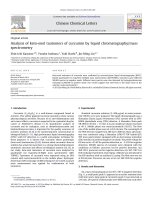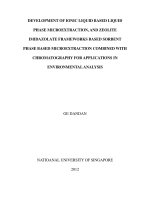Investigation and application of liquid chromatography mass spectrometry in the analysis of polar, less volatile and thermal unstable organic pollutants in environmental and biological samples 3
Bạn đang xem bản rút gọn của tài liệu. Xem và tải ngay bản đầy đủ của tài liệu tại đây (173.04 KB, 23 trang )
3. Chapter Three
Stability Studies of Carbamate Pesticide in Environmental Waters
by LC-APCI-ITMS
3.1 INTRODUCTION
Propoxur [2-(1-methylethoxy) phenyl methyl carbamate, Baygon
(R)
], an important N-
methylcarbamate, was selected as a model compound for this study since it is widely
used in controlling numerous species of household and public health pests. Due to its
high solubility and instability in water, propoxur and its TPs are potential contaminants of
the aquatic environment and food resources. Accurate, sensitive, analytical methods are
required for the monitoring of trace levels of propoxur and its TPs from pesticide-
contaminated water.
LC-MS has become an important tool for the analysis of carbamates pesticides and their
TPs because of their relatively high polarity, low volatility and thermal instability, which
prevent direct analysis by GC-MS. LC-TSP-MS, for the determination of carbamate
pesticides have been widely studied in recent years [1-5]. However, the instability of the
TSP interface, which is well documented, results in the need for extensive calibration of
sample injections and has inhibited routine use [6]. The API techniques (APCI and ESI)
are highly sensitive, show greater ionization stability and are more universally applicable
than other LC-MS techniques. Pleasance et al. evaluated APCI and ESI for the analysis of
carbamate pesticides (including aldicarb, carbofuran and 3-hydroxy-carbofuran) and
compared these techniques with TSP-MS and PB-MS [7]. Doerge and Bajic reported the
50
application of LC-APCI-MS for the determination of carbamates: carbofuran and 3-
hydroxy-carbofuran, and the analysis of triazine herbicides in water [8]. LC-ESI-MS has
been also successfully applied for the simultaneous determination of carbamate pesticides
[7, 9-12]. In addition, with the introduction of ion-trap mass analyzers (ITMS), higher
sensitivity and accuracy of the structural information on analytes can be obtained, that
achieve the requirements of the European Union for water analyses [13].
In order to investigate the degradation behavior of carbamate pesticides in various
aqueous matrices, analyses for propoxur (selected as a model carbamate) and its TPs in
aqueous samples by using LC-APCI-ITMS were carried out in this study. Our aims were
as follows: (1) To identify the major TPs of propoxur by mean of LC-API-ITMS. The
performance of two MS ionization techniques (ESI and APCI) for such identification
purposes are compared; (2) To investigate the degradation of propoxur in various waters
(ultrapure water, drinking water, rain water, seawater and river water) under different pH
and irradiation sources (sunlight, darkness, indoor incandescent lighting and artificial UV
light) by using LC-APCI-ITMS with selected ion monitoring mode; and (3) To
investigate the degradation of propoxur in environmental water at concentration level of
30 µg/L (close to natural environmental contamination levels) under various irradiation
condition (as above) by LC-APCI-ITMS.
51
3.2 EXPERIMENTAL
3.2.1 Reagents and Sample Preparation
A stock solution containing propoxur (1000 µg/ml) was prepared in methanol and diluted
with different solvents to obtain working solutions at various concentrations. Two sets of
standards of propoxur dissolved individually in methanol and ultrapure water were
prepared with the concentrations of 0.025, 0.05, 0.10, 0.25, 0.50 and 1.0 ng/µl,
respectively. A set of solvent-based (methanol: water, 50:50) standards was also prepared
at the same concentrations. All the above standards were prepared from the same stock
solutions. All the solutions were stored at 4°C in the dark.
Four natural water samples were collected from local sites (sea water, river water, rain
water and drinking water). They were filtered through a 0.45-mm membrane (Millipore)
to eliminate particulate matter before analysis. Spiked water samples were prepared by
adding an appropriate volume of spiked solutions into the ultrapure water and natural
water samples prepared as described above.
Hydrolysis products of carbamates were obtained by hydrolyzing the corresponding
carbamate esters in alkaline solutions. Propoxur dissolved in methanol (1 mg/ml; 1 ml)
was mixed with 0.5 M NaOH solution (1 ml). The mixture was heated at 70 °C for 5 h
52
and then neutralized with 1 M HCl solution. It was then analyzed by HPLC-UV (at a
detection wavelength of 225 nm) and LC-APCI-ITMS.
3.2.2 Preconcentration by Liquid-Liquid Extraction
Liquid-liquid extraction with dichloromethane was used for concentrating propoxur and
its TPs from the water samples because of the efficiency and simplicity of this extraction
method. A 100-ml sample was firstly adjusted to pH 3, and then transferred to a 250-ml
separating funnel and shaken with 20 ml dichloromethane. The lower organic layer was
decanted into a 100-ml round-bottom flask. The aqueous layer was further extracted with
two successive 20-ml portions of dichloromethane. After each successive extraction the
organic layer was decanted. All the organic fractions were combined, and evaporated to
dryness in a rotary evaporator. 1 ml of methanol was added to dissolve the residue, which
was directly analyzed by LC-MS.
3.2.3 LC-MS Measurement
The extract was analyzed by LC-API-MS (See chapter 2). Scanned acquisitions of all
tested compounds were obtained using APCI and ESI in both ionization polarities. In
order to obtain the respective optimum tuning conditions, the standard of each compound
was delivered into the API source through an electronically-controlled syringe pump.
Typical tuning conditions were:
53
Positive APCI: vaporizer temperature 450°C, sheath gas flow rate 80 arb (arbitrary units),
auxiliary gas flow rate 20 arb, discharge current 5 µA, capillary temperature 150 °C,
capillary voltage 35V, tube lens offset 5V, corona voltage 4.5 kV.
Negative APCI: the same as positive APCI except corona voltage was –4.5 kV. Positive
ESI: spray voltage 4.5 kV, capillary temperature 250 °C; other conditions as for positive
APCI.
Negative ESI: the same as positive ESI except that the spray voltage was –4.5 kV.
For the LC separation of propoxur and its TPs, a mixture of ultrapure water-methanol
(50:50) was used as mobile phase at a constant flow rate of 0.6 ml/min. A Phenomenex
(Torrance, CA, USA) ODS 150 x 3.2 mm I.D. column was used. The HPLC system was
interfaced to the ion trap through the API source. Mass spectra collected in full scan
mode were obtained by scanning over the range from 50 to 250 m/z. Maximum injection
time was set at 150 ms. Time scheduled mass conditions were as follows: LC time 0.00-
2.00 min, full scan from 50 to 250 m/z; LC time 2.00-7.00 min, SIM (selective ion
monitoring) mode (m/z 60); LC time 7:00-15.00 min, full scan as above; LC time 15.00-
22.00 min, SIM mode (m/z 151 and m/z 210), LC time 22.00-30.00 min full scan as
above, Total data acquisition time was 30 min. The HPLC was also connected a
UV6000LP UV detector (ThermoQuest), which was used to help identify the propoxur
TPs.
54
3.3 RESULTS AND DISCUSSION
3.3.1 Identification of TPs of Propoxur and Comparison of ESI and APCI
The results showed that under alkaline condition (0.5M NaOH), propoxur was
hydrolyzed to two TPs (1, and 2) completely (see Fig. 3-1(a)). When propoxur (B) was
added to the above hydrolysis product mixture, the two TPs can be effectively separated
from propoxur under HPLC (Fig. 3-1(b)). Based on the hydrolysis mechanism of
carbamates, the most likely pathway of propoxur hydrolysis is outlined and also
displayed in Fig. 3-1.
In order to confirm the TPs of propoxur hydrolysis, two LC-MS ionization techniques
(ESI and APCI) were used and compared in this study. The results show that propoxur
can be monitored at m/z 210 ([M+H]
+
) by both APCI and ESI techniques. But for its TPs
1 and 2 (in Fig.3-1), the techniques have different responses. Evidence is presented in
Fig.3-2, which shows some typical full-scan chromatograms of both TPs by using APCI
and ESI. From the figure, it is clear that TP 1 can be detected under positive-ion mode (as
[M+H]
+
)
by using both techniques (Fig. 3-2 (a) and (b); LC retention time ~ 3.3 min),
whereas TP 2, as the most intense peak [M-H]
-
,
was obtained only by using APCI under
negative-ion conditions (Fig. 3-2 (c), LC retention time ~20.4 min). There was no
obvious response by ESI in either negative or positive ion conditions. This may be due to
the lower polarity of TP 2, which makes it difficult to be ionized under the applied ESI
conditions. Furthermore, TP 1 can be confirmed to be N-methyl formamide as the base
55
peak ([M+H]
+
) was obtained at m/z 60 by both mass techniques. The other TP was 2-
isopropoxyphenol, for which the most intense [M-H]
-
ion was at m/z 151 obtained by
APCI.
Based on the above considerations and the greater flexibility regarding LC flow rates
associated with APCI, APCI was selected as the technique by which to study the
hydrolysis behavior of propoxur in water samples at various pH and irradiation
conditions.
3.3.2.Degradation of Propoxur in Ultrapure Water
3.3.2.1.Calibration curves
In order to investigate instrument sensitivity and calibration, matrix-matched and solvent-
based standards at the same concentration of propoxur were paired but analyzed in
random concentration order. Fig. 3-3 shows the calibration curves for propoxur in a
range of solvent-based standards (methanol-water 1:1) and two matrix-matched standards
(ultrapure water, methanol). It can be seen that the linear range was similar for these three
sets of standards (0.025-1.0 ng/µl). Correlation coefficients were 0.994, 0.996 and 0.995
for methanol-water-based standards, ultrapure-water-based standards and methanol-based
standards, respectively. In addition, the use of solvent-based or matrix-based standards
was found to influence precision. Thus the relative standard deviation (RSD) at the 0.1
ng/µl level for standards prepared in solvent was 5.5% (n=8) but that for the same
56
20
O
OC
O
NHCH
3
CH
3
H
3
C
+
O
CH
3
H
3
C
C
O
NHCH
3
H
OH
-
TP2
TP1
OH
1
A
B 2
10 0
(b)
20 30 (min)
1
(a)
A
2
0.005 AUFS
0.005 AUFS
0 10 30 (min)
Fig. 3-1. HPLC-UV chromatogram obtained after hydrolysis reaction under alkaline
conditions (NaOH).
(a) hydrolysis products; (b) hydrolysis products with added propoxur.
Peak identities: 1) and 2) transformation products; A) methanol; B) propoxur
57
3.32
(a)
100
0
%
Relative abundance
4 8 12 16 20 24
Time (min)
100
4 8 12 16 20 24
0
3.20
(b)
%
Relative abundance
Time (min)
(c)
20.38
100
0
%
Relative abundance
4 8 12 16 20 24
Time (min)
Fig. 3-2. Full-scan chromatograms of TPs of propoxur using LC-APCI-ITMS and LC-
ESI-ITMS. (a) transformation products by positive ESI. (b) transformation
products by positive APCI. (c) transformation products by negative APCI.
58
concentration in matrix-based standards was lower than 3.2% (n = 8). Therefore, matrix-
based standards were used throughout to quantitate the extracts in this study.
It can also be observed from Fig. 3-3 that an enhancement or suppression effect was
noticed for these three different propoxur standards. Close agreement is observed
between the two sets of matrix standards (ultrapure water, methanol) indicating only a
slight matrix enhancement effect on the ion signal, whereas the calibration curve for the
propoxur obtained from the solvent based standard (methanol-water 1:1) demonstrated a
large enhancement effect. Therefore, during the following investigation of propoxur
degradation in real water samples, methanol was used to dissolve the final target
compounds after preconcentration instead of water due to its similar effect with water on
the ion signal and the higher solubility of targets dissolved in it than in water.
80
1
2
Peak Area m/z 210 (arbitrary
units)
70
60
50
40
30
0
0
0
0
(a) R
2
=0.994
(b) R
2
=0.996
(c) R
2
=0.995
0.1 0.2 0.3 0.4 0.5 0.6 0.7 0.8 0.9 1
Concentration (ng/
µ
l)
Fig. 3-3. Calibration curves based on peak areas (m/z 210) over the concentration range
0.025 to 1.0 ng/µl. (a) Solvent-based propoxur standards. (b) ultrapure water
based propoxur standards. (c) Methanol-based propoxur standards.
59
3.3.2.2 Effect of light irradiation and pH on degradation
Carbamate pesticide can undergo three general types of degradation processes in the
aquatic environment, namely, chemical (hydrolysis), biological and photochemical.
Although there is a wealth of literature on N-methyl carbamate degradation, most of it
deals with the biochemical transformation rather than with physico-chemical
transformations, however [14]. The present study was aimed at monitoring the
degradation kinetics of propoxur in water in order to obtain its chemical degradation
curves and half lives. For this purpose, ultrapure water samples containing 1.0 ng/µl
propoxur at various pH (adjusted with dilute HCl or NaOH), under three different
conditions: natural sunlight, no light (darkness) and ordinary indoor lighting,
respectively, were studied. At different periods of time, aliquots of 10 µl were taken from
the samples and analyzed directly by LC-APCI-ITMS.
The degradation curves obtained over a 4-week period for propoxur in ultrapure water at
pH 5 (a), pH 6 (natural pH) (b), pH 7 (c), pH 8.6 (d), pH 10.5 (e), are shown in Fig. 3-4.
Water samples were periodically sampled every minute, every hour, every day, and
finally two times a week according to experimental requirements; duplicate
measurements were made in all cases. From Fig. 3-4, it can be seen that the signals for
propoxur decreased with increasing time under all applied conditions. Moreover,
propoxur degraded more significantly under natural sunlight exposure than under indoor
lighting and dark conditions, indicating that its hydrolysis is strongly light-intensity
dependent. It also can be seen from Fig. 3-4 (a) (b) (c), that propoxur remained stable for
60
a longer time under darkness and indoor lighting than under sunlight exposure. At pH 5
(Fig. 3-4 (a)), it remained stable for 24 h under darkness and at least 20 h under indoor
light, compared to only 8 h under sunlight. At the natural pH of 6 of ultrapure water (Fig.
3-4 (b)), propoxur remained stable for more than 16 hours under indoor lighting and
darkness, compared to only 4 hours’ stability when it was exposed to sunlight. However,
a very interesting observation was obtained when pH was above 8. Faster degradation
occurred under alkaline conditions. It appeared that in comparison to an alkaline
environment, all other conditions that affected degradation, such as light intensity,
became insignificant. Evidence is presented in Fig. 3-4 (d) and (e), show that at pH 8.5,
propoxur was completely hydrolyzed within 24 hours and 10 minutes (pH 10.5),
respectively, under all three different light intensity conditions.
Based on the above results, it is obvious that the effect of pH on the hydrolysis of N-
methyl carbamates is more significant than that of light intensity. Generally, mild alkaline
conditions at room temperature are sufficient to cause hydrolysis. Published literature
about carbofuran indicates that its degradation in water is very much pH-dependent, with
values of 10 or 0.58 days when the pH is raised from 7 to 8.7 [15]. The influence of pH
on the hydrolysis of propoxur in ultrapure water was investigated and results are shown
in Fig. 3-5. (To avoid continuous degradation of targets during the detection period, the
following special care must be taken here.) Aqueous samples containing propoxur at
variable pH were adjusted to pH 3 after being allowed to stand for 30 minutes, and then
direct analyzed by LC-APCI-MS. From Fig. 3-5, it is clear that the signals for propoxur
decreased with increasing pH value above 4. Above pH 8, propoxur was significantly
61
hydrolyzed in water. Less than 5 % of the propoxur was detected after 30 min in water at
pH 10 and almost 100% loss occurred at pH above 10.5. In addition, the applied
irradiation (sunlight, indoor lighting and darkness) are appeared to affect degradation at a
range from pH 5 to pH 9, which demonstrated again light intensity affected hydrolysis
only under neutral, slightly acidic, or mild alkaline conditions. Above pH 9, degradation
was so fast that pH seemed predominant. Like carbofuran, propoxur hydrolysis is also
very much pH-dependent.
3.3.2.3 Degradation kinetics
The chemical degradation of N-methyl carbamate fits a first-order degradation curve, C
t
=
C
0
e
–kt
, where C
0
and C
t
are the initial concentration and concentration at time t,
respectively. k is the first-order rate constant, which is calculated as the negative slope of
the regression line where the natural logarithm of the percentage of the compound
remaining is plotted against time (h
-1
). The half-life (t
1/2
)
designates the time at which the
pollutant concentration is equal to one-half the initial concentration (t
1/2
= ln 2/k). The
half-lives of propoxur in Milli-Q water under various conditions (pHs and irradiation) are
shown in Table 3-1. The degradation of propoxur increased with increasing k. As a result,
the half-lives decreased accordingly. For example, at pH 5, k increased from 1.70 x 10
–3
under darkness to 3.96 x 10
–3
under sunlight; correspondingly, the half-lives were
reduced from 407 h to 175 h. Based on the results of Table 3-1, a conclusion can be
drawn that the half-lives decrease in the order of increase of light intensity (darkness >
indoor lighting > sunlight), although at high pH (pH > 8.5), this decrease is slight.
62
0 100 200 300 400 500 600 700 800
0
20
40
60
80
100
120
(a)
indoor lighting
darkness
sunlight
Peak Area m/z 210 (arbitrary units)
Time (h)
0 200 400 600 800 1000
0
20
40
60
80
100
120
(c)
indoor lighting
darkness
sunlight
Peak Area m/z 210 (arbitrary units)
Time (h)
0246810
0
20
40
60
80
100
(e)
indoor lighting
darkness
sunlight
Peak Area m/z 210 (arbitrary units)
Time (h)
0 100 200 300 400 500 600 700 800
0
20
40
60
80
100
120
(b)
indoor lighting
darkness
sunlight
Peak Area m/z 210 (arbitrary units)
Time (h)
0 5 10 15 20 25 30
0
20
40
60
80
100
120
(d)
indoor lighting
darkness
sunlight
Peak Area m/z 210 (arbitrary units)
Time (h)
Fig. 3-4. Degradation curves for propoxur spiked in ultrapure water under various
irradiation and pH conditions. (a) pH 5; (b) pH 6; (c) pH 7; (d) pH 8.5;
(e) pH 10.5.
63
024681012
0
20
40
60
80
100
120
indoor lighting
darkness
sunlight
Peak Area m/z 210 (arbitrary units)
pH values
Fig. 3-5. Influence of pH on the hydrolysis of propoxur in ultrapure water under various
irradiation conditions.
Table 3-1. Rate constants (k) and half-lives (t
1/2
), for propoxur in ultrapure water
under different conditions at 25°C.
pH Irradiation k (h
-1
) t
1/2
(h)
darkness 1.70 x 10
-3
407
indoor lighting
a
2.15 x 10
-3
322
pH 5.0
sunlight 3.96 x 10
-3
175
darkness 2.12 x 10
-3
326.8
indoor lighting
a
2.65 x 10
-3
261.5
pH 6.0
sunlight 4.31 x 10
-3
160.9
darkness 2.18 x 10
-3
318.2
indoor lighting
a
2.77 x 10
-3
250.6
pH 7.0
sunlight 1.30 x 10
-2
53.3
darkness 2.26 x 10
-1
3.07
indoor lighting
a
3.30 x 10
-1
2.1
pH 8.5
sunlight 4.85 x 10
-1
1.43
darkness 1.15 x 10
-2
60
indoor lighting
a
1.33 x 10
-2
52
pH 10.5 *
sunlight 1.54 x 10
-2
45
* at pH 10.5, units of k and t
1/2
are s
-1
and s, respectively.
a
incandescent lighting
64
3.3.3 Degradation of Propoxur in Natural Water
In order to provide a better comparison with real environmental situations, degradation
studies in natural water were conducted for propoxur at a concentration of 30 µg/L,
within normal environmental levels (20-100 µg/L) of the herbicide. Different types of
water samples, namely: river water, seawater, rain water and drinking water were
selected as matrices. Because propoxur is not present in natural water in Singapore, all
the water samples were spiked with 30 µg/l of propoxur. Liquid-liquid extraction was
used here to concentrate propoxur and its TPs after hydrolysis. The degradation curves
obtained over a one-month period for propoxur at various irradiation conditions in
seawater as an example are shown in Fig. 3-6.
0 20406080100
0
20
40
60
80
100
120
140
160
indoor lighting
darkness
sunlight
Peak Area m/z 210 (arbitrary units)
Time (h)
Fig. 3-6. Degradation curves for propoxur in seawater under various irradiation
conditions.
It can be observed from Fig. 3-6 that propoxur in seawater hydrolyzed quickly, especially
under sunlight and indoor lighting. Under the above conditions, the half-lives of the
65
target were 11.5 and 12 hours, respectively. More than 50% degradation occurred within
40 hours even under darkness, probably aided by the pH (7.8) of the seawater used,
which causes rapid hydrolysis (see above). Degradation curves, describing hydrolysis
under sunlight and indoor lighting (Fig. 3-6), are quite similar. However, these were
different from that for degradation under darkness. In addition, the hydrolysis behavior of
propoxur under irradiation (either natural sunlight exposure or indoor lighting) was much
faster. For example, more than 95% of propoxur under irradiation was degraded after 72
hours (3 days), whereas less than 80% of the target disappeared under darkness over that
time. Furthermore, half-lives were estimated to be around 12 hours under both types of
irradiation, whereas under darkness, the half-life was about 35 hours.
0 100 200 300 400 500 600 700 800
0
40
80
120
160
200
drinking water
rain water
sea water
river water
Peak Area m/z 210 (arbitrary units)
Time (h)
Fig. 3-7. Degradation curves for propoxur in various matrices (drinking water, rain water,
seawater and river water) under sunlight exposure.
The effects of matrix on the degradation behavior of target were also studied. Results are
presented in Fig. 3-7, which shows the effect of irradiation time on the degradation
66
behavior of propoxur when four water samples (drinking water, rain water, seawater and
river water) respectively, were exposed to sunlight at the same time.
It is clear that degradation rates increase in the order of increasing pH (seawater [pH 7.8]
or river water [pH 7.6] > drinking water [pH 7.03] > rain water [pH 4.2]). For example,
the percentage of degradation in seawater and river water was almost 100% after 100
hours’ sunlight irradiation, but over that time only 33% of the target degraded in drinking
water. When experiments were carried out on rain water, very slight degradation was
observed during the first 100 hours. Therefore, it is obvious that the effect of pH is a
crucial factor on the degradation of propoxur in water samples. We also noticed that
degradation was much faster in both seawater and river water than in drinking and rain
water. This is because dissolved salts and organic matter possibly enhance degradation of
propoxur in sea and river water, Seiber et al. reported a remarkable decrease in the half-
life of Carbofuran in paddy field water instead of distilled water [16]. In addition,
microbial degradation in both waters can be of importance, which affects the degradation
positively, as reported for Carbaryl [17]. Furthermore, degradation behavior in drinking
water was quite similar to that in ultrapure water at pH 7. This is probably due to their
similar pH (pH of collected drinking water was 7.03). Although it could still be observed
that degradation rate was a little faster in drinking water, this slight difference is
considered to be not significant. What is surprising is that although pH of rain water was
only 4.2, propoxur degradation occurred. Nevertheless, in contrast to the result shown
previously in Fig. 3-5 in which degradation in ultrapure water (~pH 4) is depicted to be
slight, this is probably due to the dissolved particles in rain water, which had a positive
effect on degradation [16]. The comparison of degradation rate and half-life of propoxur
67
in different matrix under various light exposures were investigated and the results are
shown in Table 3-2. It can be seen that light intensity affects the K and t
½
in each natural
water sample. K increases and t
½
decreases accordingly when the light intensity increases
in the order of darkness, indoor lighting and sunlight. This indicates that light exposure
can prompt hydrolysis in various types of natural water. Thus the effect of light intensity
in natural water is similar to that in ultrapure water, that is, light intensity could affect
hydrolysis positively at mild alkali conditions. Furthermore, the degradation is very much
pH dependent as K and t
½
are significantly altered with increase in pH. For example,
when the pH of the matrix increased from 4.2 (rain water) to 7.8 (sea water), t
½
was
reduced greatly from 660 h to 18 h.
Table 3-2. Rate constants (K) and half-lives (t
1/2
), for propoxur studied under applied
light irradiations in four different water samples, respectively.
a
incandescent lighting
Matrix Irradiation K (h
-1
) t
1/2
(h)
darkness 9.12 x 10
-4
760
indoor lighting
a
1.07 x 10
-3
650
Rain water (pH 4.2)
sunlight 1.20 x 10
-3
580
darkness 2.19 x 10
-3
316.3
indoor lighting
a
2.75 x 10
-3
252
Drinking water (pH 7.03)
sunlight 1.37 x 10
-2
50.5
darkness 2.17 x 10
-2
32
indoor lighting
a
3.59 x 10
-2
19.3
River water (pH 7.6)
sunlight 4.20 x 10
-2
16.5
darkness 2.41 x 10
-2
28.7
indoor lighting
a
4.95 x 10
-2
14
Seawater (pH 7.8)
sunlight 6.08 x 10
-2
11.4
68
3.3.4 Effect of UV Irradiation
We also tested propoxur degradation in ultrapure water, rain water and seawater under
artificial light (UV lamp 220 nm - 340 nm). The results are shown in Fig. 3-8. Rapid
degradation was observed under UV irradiation, especially in seawater where complete
degradation occurred within 60 min. In the other two matrices (ultrapure water and rain
water), the degradation of propoxur was also much more serious than that in the same
matrix under any of the other light conditions applied previously. For example, about
90% of propoxur was degraded within 40 hours under UV irradiation in ultrapure water,
whereas over that time, more than 80% of the compound was intact under sunlight
irradiation in the same matrix.
0
20
40
60
80
100
120
020406080
Time (h)
Peak Area m/z 210 (arbitrary units)
ultrapure water (pH 6)
rain water
0
50
100
0204060
Time (min)
sea water
Fig. 3-8. Degradation curves for propoxur in ultrapure water, rain water and seawater
under UV irradiation.
69
3.4 CONCLUSIONS
summary, this study confirms and extends earlier findings that N-methyl carbamate
In
pesticides are not persistent in water. Propoxur was selected as a model compound to
study the degradation behavior in Milli-Q water, drinking water, rain water, river water
and seawater under various pH and irradiation sources (sunlight, darkness, indoor
lighting (incandescent) and artificial UV lighting). For the first time, liquid
chromatography-atmospheric pressure chemical ionization-ion trap mass spectrometry
(LC-APCI-ITMS) was used to investigate the chemical degradation behavior of
propoxur. Hydrolysis is very much pH-dependent irrespective of the type of water matrix.
Light intensity can prompt degradation significantly under mild alkaline conditions,
while its influence is minor at higher pH (pH > 9). Furthermore, half-lives and
degradation rates were obtained in various matrix and irradiation sources. Based on
kinetic studies, propoxur was found to degrade more rapidly at higher light exposure and
pH. The results of the present work indicated that LC-APCI-ITMS was a powerful tool to
analyze polar and thermal-labile pesticides and their TPs in terms of sensitivity, accuracy
and precision.
70
3.5 EFERENCES
] T. Kumazawa, O. Suzuki, J. Chromatogra. B 747 (2000), 241.
994) 231.
TrAC:Trends
[5] M. Honing, D. Barceló, B.L.M. van Baar, R.T. Ghijsen, U.A.T. Brinkman, J. Am.
[6] . 60 (1988) 2076.
J. Am. Soc. Mass Spectrom. 3
[8] D.R. Doerge, S. Bajic, Rapid Commun. Mass Spectrom. 6 (1992) 663.
.
aar, W.M.A.
[11
T. Brinkman, J. Chromatogr.
[13] D. Baglio, D. Kotzias, B.R. Larsen, J. Chromatogr. A 854 (1999) 207.
. Boca Raton,
[15 , Ecotoxicology and Climate, (1989) 265.
R
[1
[2] I. Liska, J. Slobodnik, J. Chromatogra. A 733 (1996), 235.
[3] D. Volmer, K. Levsen, G. Wunsch, J. Chromatogr. A 660 (1
[4] M. Honing, D. Barceló, B.L.M. van Baar, U.A.T. Brinkman,
Anal.Chem. 14 (1995) 496.
Soc. Mass Spectrom. 5 (1994) 913.
T.A. Bellar, W.L. Budde, Anal Chem
[7] S. Pleasance, J.F. Anacleto, M.R. Bailey, D.H. North,
(1992) 378.
[9] R.D. Voyksner, T. Pack, Rapid Commun. Mass Spectrom. 5 (1991) 263
[10] J. Slobodník, A.C. Hogenboom, J.J. Vreuls, J.A. Rontree, B.L.M. van B
Niessen, U.A.T. Brinkman, J. Chromatogr. A 741 (1996) 59.
] H.Y. Lin, R.D. Voyksner, Anal. Chem. 65 (1993) 451.
[12] M. Honing, J. Riu, D. Barceló, B.L.M. van Baar, U.A.
A 733 (1996) 283.
[14] B.D. Ripley, A.S.Y. Chau, Analysis of Pesticides in Water, Volume III
FL, USA, 1982.
] E.D. Magallona
71
[16] J.N. Seiber, M.P. Catahan, C.R. Barril, J. Environ. Sci. Health, B13, (1978) 131.
9.
[17]
M.S. Sharom, J.R.W. Miles, C.R. Harris, F.L. McEwen, Water Res. 14 (1980) 108
72
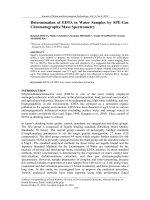
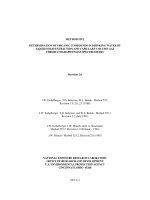
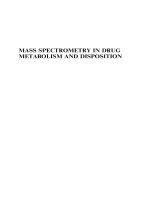
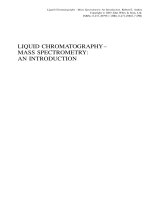
![niessen - liquid chromatography - mass spectrometry 3e [lcms] (crc, 2006)](https://media.store123doc.com/images/document/14/ne/ea/medium_eaq1401870789.jpg)
